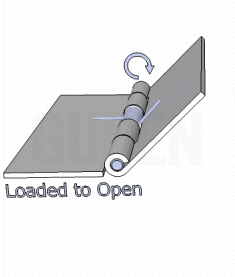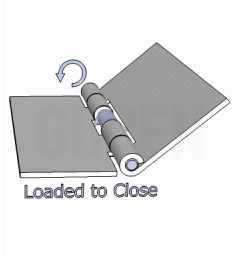Things to Consider When Choosing a Spring Hinge

Sampling and Testing
Want free spring hinge engineering samples? Sure! We know the value of prototyping and testing, and we strive to fill reasonable design sample requests quickly. Building a prototype shouldn't have to be a major expense and an engineering analysis of a prototype is usually the best way to confirm that you have selected a safe and effective product for your application. Working with the right supplier is the key to the success of your design process and you've already made a great choice with Guden, the hardware experts. With almost 100 years of experience, the samples, information and advice you can get from us can be priceless in getting your prototype off the ground and onto the production floor.
Spring Load Direction

 The first thing to decide about a spring hinge is which spring load direction your application requires.
And with over 70 different stock spring hinges, you can choose from either spring-loaded-to-open and spring-loaded-to-close versions,
and in sizes from .75” wide by 1.25” long up to 1.50” wide by 8.75” long.
The first thing to decide about a spring hinge is which spring load direction your application requires.
And with over 70 different stock spring hinges, you can choose from either spring-loaded-to-open and spring-loaded-to-close versions,
and in sizes from .75” wide by 1.25” long up to 1.50” wide by 8.75” long.
Hinges that are spring-loaded open will push the leaves into the open position, or away from each other. Hinges that are spring-loaded
to close will push the leaves into the closed position, or towards each other. Depending on what side of the panel or door you are
mounting the spring hinge leaf, you always have to follow which way the spring leg is pushing the leaf to understand what kind of action
you will get.
Spring Force & Size
Choosing a standard spring hinge is often the most cost effective solution. We recommend first starting with a Guden stock spring hinge and then seeing how it works in your application. With this as a starting point, we can look to either add to that tension, or subtract from it. It may be as simple as looking at a stronger or weaker stock spring hinge or sometimes just adding another spring hinge to your door, or maybe just having one less. Often times we can supply a spring hinge with several torsion springs that you can begin removing to try to select the amount of spring force that you require. If a standard item just doesn't seem to do the trick, in many cases we can supply a spring hinge with a custom torsion spring created right to your specifications.
Leaf Material and Thickness
| • Cold Rolled Steel - Affordable |
| • Zinc Plated Steel - Affordable with Added Corrosion Resistance |
| • Stainless Steel - Corrosion Resistant |
| • Aluminum - Lightweight |
The more popular choices for material in a spring hinge are plain steel, zinc plated steel, and type 302/304
stainless steel. You can also get them custom made in type 316 stainless steel, and also in aluminum. The pin is most often the same
material as the leaf, and the springs can be steel spring wire, or stainless steel. It is also common to have the hinge material
match the material of the cabinet or box.
For material thickness, a good starting point is to select the same thickness as the enclosure. If the enclosure has some unusual
weight distribution, or a high or low door loads you may want to increase or possibly decrease the thickness.
Pin Size and Retention
| • Staked Pin - the knuckle is lightly punched to grip the pin |
| • Coined Pin - the pin is flattened, then forced in, to grip tightly |
| • No Pin Retention |
There are usually only 1 or 2 choices of pin diameter for a given thickness of a spring hinge. As a general rule of thumb, the strongest spring hinge is one where the pin diameter is about twice the material thickness. The above listing are some of the most popular methods for pin retention on spring hinges, and in some cases, the tension of the spring coil tends to hold the pin in place so no retention is needed.
With or Without Mounting Holes
| • No Holes for Welding |
| • Standard Holes or Slots |
| • Standard Countersunk Holes |
| • Custom Holes or Slot Sizes and Patterns |
The majority of spring hinges without holes are welded, but for easier mounting, many spring hinges are supplied with either holes, slots or custom threaded inserts or studs. Various standard hole patterns are readily available and just about any hole pattern you would require can also be supplied but dependent on where the spring leg lays on the leaf. Keep in mind that some non-standard patterns may require a tooling charge.
Custom Bends / Cuts / Swages
Don't forget that if you plan to modify the hinge, it might be cost effective to have the supplier do the custom operations for you. In addition to holes, slots and plating, hinges can be cut to length, bent, swaged, offset, and trimmed - nearly anything is possible. But again, depending on the spring leg locations. You may also be altering the spring force of the spring if you add an offset or swage to the spring hinge leaves as the spring leg may not lay flat. Simply provide us with a dimensional drawing to get a price quote.
Common Finish Options
| • Chemical Conversion | • Degrease | • Powder-coat |
| • Anodize | • Electro-Galvanize | • Polish |
| • Black Oxide | • Electropolish | • Passivated |
| • Burnished | • Nickel | • Zinc |
| • Chrome | • Paint | • NADCAP |
One of the last decisions to make on your hinge is the finish. Often your spring hinge will be finished along with the rest of your assembly, but if needed, Guden can supply the hinge with your specified finish. Most spring hinges are in stock without a finish.
Considering a Spring Hinge for your application? Click here to see our standard Spring hinges



